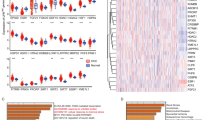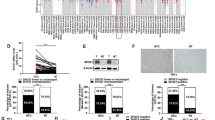Abstract
Background
Hepatocellular carcinoma (HCC) is the most common malignancy in the world, especially in China. Early diagnosis of new and recurrent hepatocellular carcinoma, followed by timely treatment, will help decrease mortality. Currently biomarkers are not satisfactory. Better diagnostic methods are highly demanded.
Methods
In this study, we have used in silico identification and RT-PCR test and discovered a hepatoma associated gene (HTA). Knockdown of endogenous HTA expression was performed by small interfering RNA in malignant hepatocyte HepG2. Then we tested the cell proliferative ability of these cells in vitro and in vivo.
Results
HTA was expressed specifically in some kinds of tumors, but not detected in any normal tissues. It was expressed especially high in hepatocellular carcinoma. Knockdown of endogenous HTA expression in HepG2 by small interfering RNA attenuated HCC cell growth.
Conclusions
HCA is a very good marker for tumors, especially for HCC. It could play important roles in HCC development and progression and can be a promising molecular target for the development of new diagnostic and therapeutic strategies for HCC.






Similar content being viewed by others
Abbreviations
- HCC:
-
Hepatocellular carcinoma
- HTA:
-
Hepatoma associated gene
- AFP:
-
Alpha-fetoprotein
- RT-PCR:
-
Reverse transcription-PCR
References
Aouacheria A, Navratil V, Barthelaix A, Mouchiroud D, Gautier C (2006) Bioinformatic screening of human ESTs for differentially expressed genes in normal and tumor tissues. BMC Genomics 7:94. doi:10.1186/1471-2164-7-94
Chen Y, Miller C, Mosher R, Zhao X, Deeds J, Morrissey M, Bryant B, Yang D, Meyer R, Cronin F, Gostout BS, Smith-McCune K, Schlegel R (2003) Identification of cervical cancer markers by cDNA and tissue microarrays. Cancer Res 63(8):1927–1935
El-Serag HB (2004) Hepatocellular carcinoma: recent trends in the United States. Gastroenterology 127(5)(Suppl 1):S27–S34. doi:10.1053/j.gastro.2004.09.013
Imyanitov EN, Togo AV, Hanson KP (2004) Searching for cancer-associated gene polymorphisms: promises and obstacles. Cancer Lett 204(1):3–14. doi:10.1016/j.canlet.2003.09.026
Jemal A, Murray T, Ward E, Samuels A, Tiwari RC, Ghafoor A, Feuer EJ, Thun MJ (2005) Cancer statistics, 2005. CA Cancer J Clin 55(1):10–30
Loging WT, Lal A, Siu IM, Loney TL, Wikstrand CJ, Marra MA, Prange C, Bigner DD, Strausberg RL, Riggins GJ (2000) Identifying potential tumor markers and antigens by database mining and rapid expression screening. Genome Res 10(9):1393–1402. doi:10.1101/gr.138000
Ogawa H, Tamaki H, Ikegame K, Soma T, Kawakami M, Tsuboi A, Kim EH, Hosen N, Murakami M, Fujioka T, Masuda T, Taniguchi Y, Nishida S, Oji Y, Oka Y, Sugiyama H (2003) The usefulness of monitoring WT1 gene transcripts for the prediction and management of relapse following allogeneic stem cell transplantation in acute type leukemia. Blood 101(5):1698–1704. doi:10.1182/blood-2002-06-1831
Okuda H, Nakanishi T, Takatsu K, Saito A, Hayashi N, Takasaki K, Takenami K, Yamamoto M, Nakano M (2000) Serum levels of des-gamma-carboxy prothrombin measured using the revised enzyme immunoassay kit with increased sensitivity in relation to clinicopathologic features of solitary hepatocellular carcinoma. Cancer 88(3):544–549. doi:10.1002/(SICI)1097-0142(20000201)88:3<544:AID-CNCR8>3.0.CO;2-F
Reis EM, Ojopi EP, Alberto FL, Rahal P, Tsukumo F, Mancini UM, Guimarães GS, Thompson GM, Camacho C, Miracca E, Carvalho AL, Machado AA, Paquola AC, Cerutti JM, da Silva AM, Pereira GG, Valentini SR, Nagai MA, Kowalski LP, Verjovski-Almeida S, Tajara EH, Dias-Neto E, Bengtson MH, Canevari RA, Carazzolle MF, Colin C, Costa FF, Costa MC, Estécio MR, Esteves LI, Federico MH, Guimarães PE, Hackel C, Kimura ET, Leoni SG, Maciel RM, Maistro S, Mangone FR, Massirer KB, Matsuo SE, Nobrega FG, Nóbrega MP, Nunes DN, Nunes F, Pandolfi JR, Pardini MI, Pasini FS, Peres T, Rainho CA, dos Reis PP, Rodrigus-Lisoni FC, Rogatto SR, dos Santos A, dos Santos PC, Sogayar MC, Zanelli CF, Head and Neck Annotation Consortium (2005) Large-scale transcriptome analyses reveal new genetic marker candidates of head, neck, and thyroid cancer. Cancer Res 65(5):1693–1699. doi:10.1158/0008-5472.CAN-04-3506
Roberts LR, Gores GJ (2006) Emerging drugs for hepatocellular carcinoma. Expert Opin Emerg Drugs 11(3):469–487. doi:10.1517/14728214.11.3.469
Schmitt AO, Specht T, Beckmann G, Dahl E, Pilarsky CP, Hinzmann B, Rosenthal A (1999) Exhaustive mining of EST libraries for genes differentially expressed in normal and tumour tissues. Nucleic Acids Res 27(21):4251–4260. doi:10.1093/nar/27.21.4251
Shariat SF, Kattan MW, Erdamar S, Nguyen C, Scardino PT, Spencer DM, Wheeler TM, Slawin KM (2003) Detection of clinically significant, occult prostate cancer metastases in lymph nodes using a splice variant-specific RT-PCR assay for human glandular kallikrein. J Clin Oncol 21(7):1223–1231. doi:10.1200/JCO.2003.08.142
Sterling RK, Jeffers L, Gordon F, Sherman M, Venook AP, Reddy KR, Satomura S, Schwartz ME (2007) Clinical utility of AFP-L3% measurement in North American patients with HCV-related cirrhosis. Am J Gastroenterol 102(10):2196–2205. doi:10.1111/j.1572-0241.2007.01405.x
Szallasi Z (1998) Bioinformatics. Gene expression patterns and cancer. Nat Biotechnol 16(13):1292–1293. doi:10.1038/4381
Author information
Authors and Affiliations
Corresponding author
Additional information
Y. Liu and Y. Li contributed equally to this paper.
Rights and permissions
About this article
Cite this article
Liu, Y., Li, Y., Guo, F. et al. Identification of HTA as a novel-specific marker for human hepatocellular carcinoma. J Cancer Res Clin Oncol 136, 1187–1192 (2010). https://doi.org/10.1007/s00432-010-0767-1
Received:
Accepted:
Published:
Issue Date:
DOI: https://doi.org/10.1007/s00432-010-0767-1




